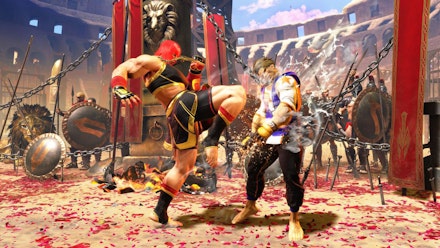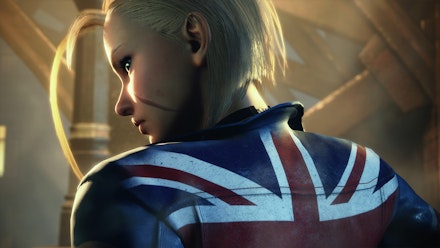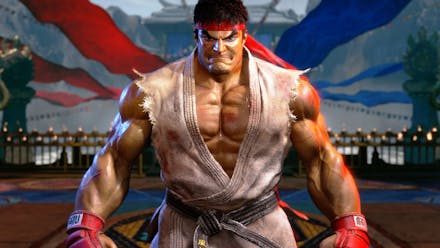Platforms: PS5, PS4, Xbox Series X|S, Xbox One, PC
Cast your mind back to 2016. It was a terrible year for many reasons, but one of its oft-forgotten sins is the state that Street Fighter V launched in. It suffered server woes that blighted online play, lacked an arcade mode – surely the barest of bones in a fighting game! – and, barring a competent tutorial explaining the intricacies of its systems, had a single player offering that wasn’t l much to write home about either. While Capcom spent the months and years afterwards fixing and tweaking the game, eventually bringing it up to tournament standard, it’s easy to understand why some worried Street Fighter 6 might suffer a similar fate. Fear not, though – the latest bout in the globe-trotting fighting series is a delight from the first punch thrown.
In many ways, it builds on the strengths of its predecessors, with a satisfying flow to battles and a host of gorgeous arenas to fight in. Although everything is rendered in 3D, as has been the case since Street Fighter IV, rounds continue to take place on a 2D plane, allowing for all the back-and-forth gameplay fans expect, vying for area control or trapping your opponent in a corner to hammer them with combos. If you haven't played Street Fighter in years, you can still jump in and feel immediately at home. Plus, with eighteen characters at launch – six of them brand new to the series – there’s no shortage of fighters to get to grips with.

The big shift is the new Drive System, the latest in Street Fighter's line of combat-modifying power gauges. You'll be able to 'spend' chunks of this for a variety of effects – Drive Reversals, similar to SF5's V-Reversals, can break off an enemy's attack, ruining their combos and giving you a bit of breathing room. Drive Rush lets you burst forwards, linking attacks and combos that might not otherwise combine. Best of all is Drive Impact, which shatters through up to three incoming attacks to deliver an even more powerful one of your own, potentially turning the tables in a tough match. The only real counter to a Drive Impact is one of your own, which makes SF6 surprisingly psychological as you try to read opponents' moves or tempt them into using a Drive Impact on you in order to counter with yours. Overall, it's one of the best systems Capcom has ever introduced in the series, and along with splashes of vibrant colour, one of the flashiest, too.
One of the best aspects of the game though is away from the actual versus mode fighting, with the single-player World Tour.
Other improvements include those aforementioned control intricacies, which are ameliorated thanks to multiple input methods. For purists, there's the traditional Street Fighter six-button approach, with heavy-medium-light kicks and punches allowing for all the precision and complexity fans have come to expect. Yet that complexity has itself been accused of scaring off newcomers, so Capcom has introduced the 'Modern' layout. This is arguably better suited to controller play, with special moves assigned to a single button paired with a directional input, with throws, assists, Drive Impacts and Drive Parries mapped to shoulder buttons. For returning players, this stripped back approach feels quite strange, especially if you've spent years memorising combos for favourite characters, but it's going to do wonders for making the game more accessible.
Capcom also, wisely, isn't segregating players using each play style – there's a marker onscreen indicating which control scheme rivals are using, but the rest comes down to mastering SF6's systems. It's Street Fighter with added egalitarianism, making ranked competitive play viable for those without an arcade stick peripheral. A third control method, the incredibly stripped back 'Dynamic' mode, is restricted though, but since this includes an AI driven auto-battle feature aimed at bringing total beginners into the game, that's to be expected.

One of the best aspects of the game though is away from the actual versus mode fighting, with the single-player World Tour. This story-driven side of the game sees you building an avatar from one of the most spectacularly detailed character creators we've seen, then guiding them through a 25 to 30-hour action-adventure/RPG hybrid. Almost anyone you cross paths with is up for a scrap – at which point World Tour switches from its 3D exploration mode to Street Fighter's traditional 2D battle plane – with experience earned from each victory.
The main thrust of the story is your character travelling around the Street Fighter world, learning from masters (the more iconic characters) to "learn the true meaning of strength". That means starting off in a gym run by SF5's Luke, where training involves wandering Metro City – SF and Final Fight's proxy for New York – and buying stat-boosting accessories from fashion stores, or battling gang members who roam the streets wearing cardboard boxes. It means doing kung-fu with Chun-Li in Chinatown, or travelling to India to study under Dhalsim. Each master you win over unlocks their unique fighting style for you to use, but more importantly, means you can rank up your friendship with them and take selfies. It's all brilliantly bonkers in the best way, and while World Tour may not be the big draw for the more competitive side of Street Fighter fandom, it's an absolute joy for the less ardent.
You'll also be able to take your custom character into SF6's last big mode, the online focused Battle Hub. While you can bypass it and jump straight into a brawl through the system menus, the Battle Hub presents a sort of virtual arcade to explore – complete with retro Capcom games to play – and interact with other players. It's here where you'll want to show off your most imaginative character build, pick up new cosmetics, and even be able to sit down at actual arcade cabinets to launch into a versus match. It's an incredibly fun addition, and really speaks to the social and community aspect of the fighting genre fandom.
There are some concerns with Street Fighter 6. Like its most recent precursor, it's envisaged as a live service game, with both DLC characters to be drip-fed into the game and, of more concern, a premium in-game currency, although Capcom says micro-transactions won't amount to pay-to-win. However, as a live service game, any problems that emerge can be tweaked and corrected over the months and years to come, and this has the benefit of launching in a much stronger starting state than Street Fighter V did. If Capcom has been searching for the true meaning of strength since that game, they've found it in Street Fighter 6.
